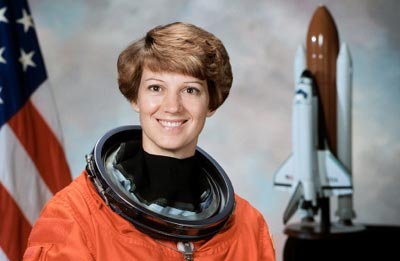The first woman on the Moonby Anthony Young
|
| Practically anyone can name the Mercury Seven, but the first seven American women in space is a question for a game show. |
If NASA was currently flying missions to the Moon, no doubt the agency would select Collins to be the first woman on walk on the lunar surface. It doesn’t look like that will happen anytime soon. 2015 is the earliest hoped-for return to the Moon by the United States within the new Vision for Space Exploration. Collins is 48, so run the math. She has been with the agency for 15 years, but that can’t hold a candle to John Young, who recently retired from NASA after 42 years with the agency. Would Collins like to place her boot on luna firma? No doubt she would. Does she want to wait ten-plus years to do so? Maybe someone should ask her. Two things are for certain: she won’t be alone, and there will be a first woman on the Moon. She is alive right now. She may have just joined the astronaut corps, or she may still be in college with plans to join the Air Force and perhaps dreaming of becoming an astronaut. Whoever it is, she will probably follow much the same path that Eileen Collins did.
The glass stratosphere
Women have tried to get into space ever since Project Mercury. That subject has been ably covered by Martha Ackmann in her book, The Mercury 13: The Untold Story of Thirteen American Women and the Dream of Space Flight published in 2003. The subject of women in space was expanded in Almost Heaven: The Story of Women in Space written by Yale historian Bettyann Kevles, also published in 2003. Of course, no American woman flew during Mercury, Gemini, or Apollo; only the Soviets flew a single female cosmonaut and then for political advantage—read propaganda. It was the Cold War. NASA wouldn’t accept women applicants to the astronaut corps until 1978. The first American woman to fly into space aboard the space shuttle was Sally Ride in 1983, and the glass stratosphere was finally shattered. However, the names of the many women who followed aboard the space shuttle can only be learned through a search on the web. Practically anyone can name the Mercury Seven, but the first seven American women in space is a question for a game show. Sadly, these female pioneers of space are an enigma and virtually unknown today. Nevertheless, they paved the way, and that way now points to the Moon and eventually Mars.
“That’s one small step for a woman…”
The shuttle never achieved its lofty launch schedule promised early in the program. If it had, even more women could boast of having flown in space. Being an astronaut today is a waiting game. Many astronauts, both men and women, trained yet never flew. The unspoken belief among many in the space community is that we are witnessing the last of the shuttle flights right now, because if there is one more catastrophic failure of the orbiter, there will be no more flights. Michael Griffin is right to accelerate the timeline for the Crew Exploration Vehicle. With the infrastructure already in place at KSC, it comes as no surprise a shuttle-derived launch vehicle is the frontrunner for the CEV. That just may close the gap between the retiring shuttle fleet and the new CEV and its launch vehicle. Certainly, ten years is an achievable goal in landing American men and women on the Moon. What will the first woman on the Moon say as she steps down off the ladder to the lunar surface? We will just have to wait to find out.
